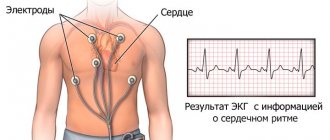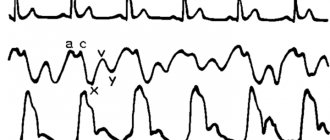A person's heart rate is constantly changing, depending on various factors. During the day, normal heartbeat can be replaced by tachycardia (rapid pulse), and then bradycardia (slow pulse). During physical activity, an increase in pulsation is common to everyone. Simply walking causes the heart muscle to contract faster. You should know what heart rate is considered normal when walking, and at what levels you need to contact a specialist.
A little theory
The pulse is the rhythmic movement of the artery walls that occurs due to cardiac activity. This is the most important biomarker of human health, which was first noticed in ancient times.
In simple terms, the heart “pumps blood” by making jerky movements. The entire cardiovascular system, including the arteries through which blood moves, reacts to these shocks. At the same time, heart rate and pulse are not the same thing, since not every heart beat generates a wave that reaches the radial artery. However, the higher this difference, the greater the so-called pulse deficit, inflated values of which indicate the presence of diseases of the cardiovascular system.
Let's see what effect walking has on heart rate:
- During a walk, the blood is saturated with oxygen, the body becomes healthier, and immunity increases;
- The cardiovascular system is strengthened;
- There is a normal load on all muscle groups, in which the body does not work for wear. Therefore, such training is allowed for the elderly, children, pregnant women, and people who are regaining physical shape after serious illnesses or injuries;
- There is an activation of metabolic processes, wastes and toxins are more actively eliminated, and moderate fat burning occurs.
- Walking is an excellent exercise for preventing varicose veins, and is also one of the few approved sports activities for obese people. During such training, they can easily maintain a normal heart rate, which is important for performance.
In 60 minutes of walking at a moderate pace, you will burn at least 100 kcal.
Pulse measurement methods
Any physical activity requires monitoring your heart rate. To make it easier to monitor them, it is worth using special devices. The simplest of them is a heart rate monitor.
It should be fixed on your hand and monitor changes in heart rate while walking. Thanks to the use of such a device, there is no need to stop to determine the required parameter.
Monitoring your pulse while moving is important for assessing a person's health status. If it is within normal limits and recovers quickly after stopping, there is no need to worry. If this does not happen, you should consult a doctor.
Normal for women
Walking for ladies is an extremely useful activity. It improves well-being, lifts your mood, and promotes weight loss. Useful for expectant mothers as it provides an additional supply of oxygen.
The normal heart rate when walking in middle-aged women (20-45 years old) is 100 – 125 beats/min. At rest, 60-100 beats/min are considered normal.
Please note that if regular observations show that the values are within the normal range, but are always within the upper limit, this is not a good sign. Especially if other “bells” are observed - pain in the sternum, shortness of breath, dizziness, and other painful sensations. If a woman’s normal pulse rate is regularly exceeded while walking, it is advisable to make an appointment with a therapist who will provide referrals to specialists.
However, high pulse rates do not always signal illness. Often this is just a consequence of a sedentary lifestyle and lack of exercise. Start practicing walking without extreme stress. Gradually increase the speed and duration of the session, constantly monitoring your pulse value. As soon as the latter exceeds the norm, slow down, calm down, then continue. Over time, the body will certainly get stronger.
Impact of walking
As you know, when walking, muscles begin to actively work, which means the consumption of energy resources increases. Daily walks in the fresh air saturate the body with oxygen, therefore, the activity of the immune system is also activated. While walking, the body burns fat tissue well. If you are doing race walking to lose weight, you should know what your heart rate is when walking.
It is very important to monitor your indicators, because they will tell you whether you have any underlying diseases. While walking, your heart rate should be normal. Only in this case can they benefit your health.
https://www.youtube.com/watch?v=OadCn525R50
With active movement, the need for oxygen in all organs increases sharply. This is why your heart rate increases after exercise.
The heart receives a signal that it needs more oxygen and begins to work at an accelerated pace to ensure the required volume of oxygen is supplied.
To find out whether the heart is working correctly and whether it is receiving adequate loads, it is necessary to take into account the normal heart rate after various physical activities.
The normal values may vary depending on the physical fitness and age of the person, so to determine it, the maximum heart rate formula is used: 220 minus the number of full years, the so-called Haskell-Fox formula. From the obtained value, the normal heart rate will be calculated for different types of loads, or training zones.
When walking
Walking is one of the most physiological states of a person; it is customary to start morning exercises with walking in place as a warm-up. For this training zone - when walking - there is a heart rate rate equal to 50-60% of the maximum value. For example, let’s calculate the heart rate rate for a 30-year-old person:
- Let's determine the maximum heart rate value using the formula: 220 – 30 = 190 (bpm).
- Let's find out how many hits make up 50% of the maximum: 190 x 0.5 = 95.
- In the same way - 60% of the maximum: 190 x 0.6 = 114 beats.
Cardio classes, or cardio training, that is, training for the heart, are especially popular among middle-aged people. The goal of such training is to strengthen and slightly enlarge the heart muscle, thereby increasing the volume of cardiac output. As a result, the heart will learn to work slower, but much more efficiently. The normal heart rate during cardio is calculated as 60-70% of the maximum value. An example of calculating heart rate for cardio training for a 40-year-old person:
- Maximum value: 220 – 40 = 180.
- Acceptable 70%: 180 x 0.7 = 126.
- Acceptable 80%: 180 x 0.8 = 144.
The resulting normal heart rate limits during cardio training for 40-year-old people are from 126 to 144 beats per minute.
Slow running perfectly strengthens the heart muscle. The normal heart rate for this training zone is calculated as 70-80% of the maximum heart rate:
- Maximum heart rate: 220 – 20 = 200 (for 20-year-olds).
- Optimally acceptable when running: 200 x 0.7 = 140.
- Maximum permissible when running: 200 x 0.8 = 160.
As a result, the normal heart rate when running for 20-year-olds will be from 140 to 160 beats per minute.
There is such a thing as the fat burning zone (FZZ), which is the load at which maximum fat burning occurs - up to 85% of calories. As strange as it may seem, this happens when training matches the intensity of the cardio. This is explained by the fact that at higher loads the body does not have time to oxidize fats, so muscle glycogen becomes the source of energy, and it is not fat deposits that are burned, but muscle mass. The main rule for HLS is regularity.
In athletes
The type and intensity of physical activity is of great importance. For example, endurance runners have a lower heart rate during exercise than strength athletes.
One should also take into account the physiological state of those involved in sports (the degree of morphological changes in the myocardium, body weight) and the fact that at rest the heart rate of athletes is significantly lower than that of untrained people. Therefore, the calculated values may differ from the real ones by 5-10%. Sports doctors consider the heart rate level before the start of the next workout to be more indicative.
For more accurate calculations, there are complicated calculation formulas. They are indexed not only by age, but also by individual heart rate at rest and the percentage of training intensity (in this case, 80-90%). But these calculations represent a more complex system, and the results are not too different from those used above.
The influence of heart rate on the effectiveness of training
To keep the body in good shape, a person needs movement. During walking, complex biomechanical and neurophysiological systems begin to work in the body. Their combined effect has a general healing effect on the entire body:
- If a person is engaged in race walking, then the work of all leg muscles is added. This tones the whole body, accelerates the blood, improves nutrition of all organs, saturated with oxygen and nutrients. Metabolic processes accelerate;
- Regular walks in the fresh air improve well-being and strengthen the immune system. Walking is beneficial at any age;
- Walking makes muscle tissue work, preventing its degradation;
- Active body work improves blood circulation, normalizing cardiac function;
- Respiratory function stabilizes.
During exercise, the heart rate increases depending on the intensity of body movements. Determining heart rate (heart rate) requires measuring pulsation over several days. Measurements are carried out at the same time of day, taking into account that the pulsation is less frequent in the morning. Body position plays an important role.
Physical activity, even in mild form, leads to an increase in heart rate. Up to 100 beats per minute is considered an indicator of excellent physical fitness, up to 120 beats - average fitness and normal for light loads, more than 120 beats per minute indicates insufficient physical fitness. Heart rate (HR) is an assistant in determining the permissible load limit for your own body. A high indicator (up to 200 shocks) indicates that the load is too high.
Normal for men
The normal heart rate when walking in men is not much different from the indicators for women. However, nature still dictates that a man must spend more energy on life activities than a woman. Kill the mammoth there, protect the family from the dinosaur. Men have larger muscles, a skeleton, and other hormonal processes.
Therefore, at rest, a pulse value of 60-110 beats per minute is acceptable for them, but only on condition that the person leads an active lifestyle. The normal pulse during fast walking in men should not exceed 130 beats/min, while a slight “+/-” to the sides is allowed.
It is important to monitor your general condition during the period of highest stress - is there any shortness of breath, tingling in the heart, or weakness. If you have alarming symptoms, it is better to consult a doctor.
The importance of training
Walking is considered very light physical activity. But at the same time, it can provide incredible benefits to our body. Scientists have long established the benefits of walking and advise all people who have no contraindications to this exercise to walk as often as possible. This will not only burn extra calories, but will also keep your body toned. Even a fifteen-minute walk will bring invaluable benefits to your health.
Man is born to move. During movements, the body activates metabolic processes and allows tissues and organs to be actively saturated with oxygen. This is why daily walks are so important in the life of every person.
Normal in children
So, we have found out what the pulse should be during normal walking for men and women, now we will consider the norm for children.
Remember your little ones: how often do we get touched, where do they get so much energy? Indeed, a child’s body functions much more intensively than an adult’s, and therefore all processes proceed faster. Children are constantly growing, and this requires a lot of effort. This is why a high heart rate when walking in a child is not a violation.
Tall, based on the parameters for adults. For children it is quite normal. Do you remember what is the normal heart rate for an adult when walking, we wrote about this above? From 100 to 130 beats/min. How much do you think a child's heart rate should be when walking? Remember, the normal range is from 110 to 180 beats/min!
At the same time, age is of great importance - closer to 10-12 years, the standard is compared with the indicators for an adult. After walking or at rest, the children's pulse should be in the range of 80-130 beats/min (for children from 6 months to 10 years).
If you are wondering what a child's heart rate should be when walking fast at a specific age, use the universal formula:
A = ((220 - A) - B) * 0.5 + B;
- A – child’s age;
- B – pulse at rest;
- N – pulse value during sports activity;
Let's say your son is 7 years old. You measured his rhythm before walking and got a value of 85 beats per minute. Let's do the calculation:
((220-7)-85)*0.5+85 = 149 beats/min. This indicator for this child will be considered the “golden” norm. Of course, we recommend using special heart rate monitors.
Normal heart rate at rest
Nordic walking with ski poles is becoming increasingly popular.
To determine the normal heart rate (HR), it is necessary to measure the indicator for several days in a row. When performing this procedure, it is worth considering the time of day. In the morning the pulse is slower than in the evening.
The position of the torso is also important. To get the correct result, experts advise taking measurements in a sitting position at 10 am.
In childhood, the normal parameters of heart rate per minute are at the following level:
- 140 – in newborns;
- 120 – at 1-2 years;
- 100 – for preschool children;
- 80 – for children 8-14 years old;
Average heart rate for an adult:
- 65-90 – for women;
- 60-80 – for men;
- 70-90 – in older people.
To evaluate the indicator, you can use the palpation method. To do this, place the middle and index fingers of the right hand on the radial artery of the left hand. They should be in the zone where the heart pulsation can be felt. After this, pulse beats are counted for 30 seconds. The resulting figure must be multiplied by 2. This will give you the number of beats per minute.
When determining heart rate, the breathing cycle, which includes inhalation, exhalation and pause, is of no small importance. Under normal conditions, there are 4-6 beats per cycle. If there is a rarer or more frequent heartbeat, this indicates disturbances in the body. An indicator of 9 beats per 1 breathing cycle is considered the heart rate limit.
During the measurement, it is important that the parameters are uniform over 100 blows. If this criterion is violated, a person may be suspected of having heart failure or another pathology.
Important: It is worth considering that after eating, a slight increase in heart rate may occur.
The lowest parameter is observed in a horizontal position. If a person is sitting, the rate increases by 5 beats per minute. When a person gets up, the pulse rises by 10-15 beats.
Normal in older people
Almost every person, upon reaching the age of 60, is recommended to take daily walks. Walking helps improve blood circulation, warms up muscles well, and has a general strengthening effect on the entire body. Walking does not cause sudden increases in heart rate, which is why such a load is called gentle.
The normal pulse of an elderly person when walking should not differ from the value for an adult, i.e. it is 60-110 beats/min. However, in their seventh decade, people often have various chronic diseases that in one way or another affect the cardiovascular system.
Acceptable heart rate values when walking for older people should not go beyond 60-180 beats/min. If the indicators turn out to be higher, walk more slowly, rest more, and do not strive to set records. It is still necessary to move, at least to get a good breath of fresh air. If you experience painful tingling in the heart area, dizziness or any other ailments, immediately stop training. If painful manifestations occur frequently, visit a doctor.
What to do if your heart rate is high?
So, now you know what your heart rate should be when walking fast - the norm for women and men of different ages is almost the same. In conclusion, we will tell you what to do if you suddenly find out that your parameters are far from ideal. By the way, this condition is called tachycardia in medicine.
- If your pulse rate jumps while walking, stop, take a deep breath, calm your heart;
- If you have an increased value even at rest, we recommend that you undergo a cardiovascular health test in the hospital.
It is also advisable to lead a healthy lifestyle, stop smoking and drinking alcohol, do not overeat fatty foods, and avoid stress.
If you suddenly have an attack of tachycardia, which is accompanied by acute pain, immediately call an ambulance. While you are waiting for the team, try to find a comfortable position, relax and breathe deeply. If you are interested in heart rate while running, then we recommend reading our material!
Well, now you know what the average heart rate should be when walking for a healthy person - the norm may deviate slightly by +/- 10 beats/min. Try to maintain a healthy range and in this case the walk will not only be pleasant, but also useful. Be healthy.
Heart rate during sleep
A person's normal heart rate during sleep decreases slightly, by about 8-10%. This occurs due to deep relaxation of the body, as well as a decrease in metabolism.
The slowdown in heart rate occurs gradually after falling asleep, but may fluctuate slightly for some reasons, for example: physical condition, age, emotions.
Walking, like other physical activity, needs to be controlled. The easiest way is to measure your heart rate while walking and compare it with normal values. This is what this simple service is designed for. If you have a pedometer with a heart rate monitor, then you can always be aware of changes in your heart rate. This service will tell you its acceptable limits. This will help you not only preserve your health, but also achieve efficiency when walking.
| Select your age in completed years: |
How it works?
(220 is your age) X 0.65
According to the service, this is a normal pulse, it is marked in green.
But due to the individual characteristics of the body, we expand the range of normal heart rate to 0.6-0.7. These are the two extreme numbers, highlighted in yellow. As you can see, everything is simple.
IMPORTANT: the values provided by the service are indicative in nature and have no medical value. Before serious walking, consult your doctor!











